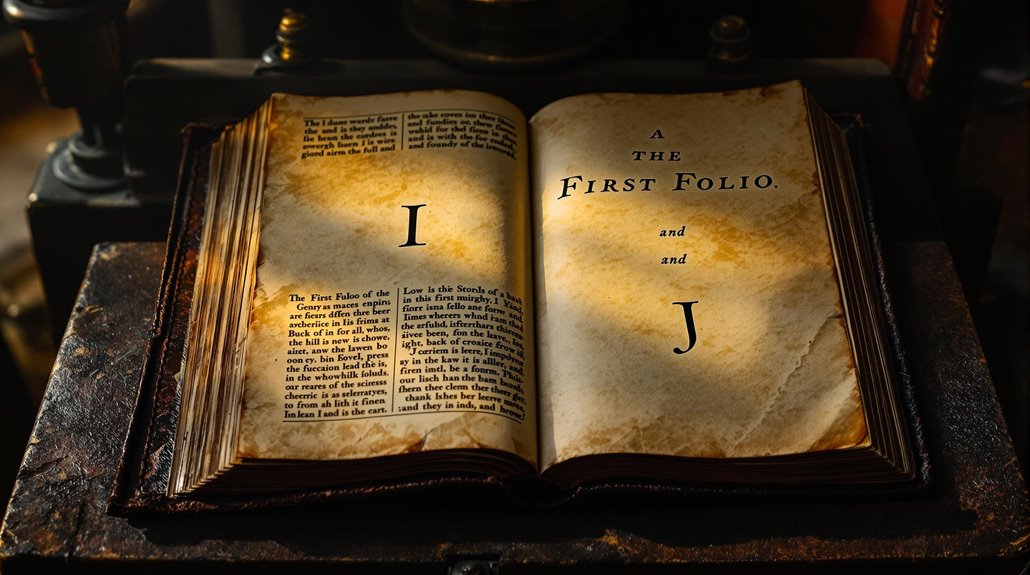The Letter “J” Wasn’T Distinct From “I” Until After Shakespeare’S Time
You might be surprised to learn that one of our alphabet's most familiar characters lived a rather mysterious double life for centuries. When you look at Shakespeare's original works, you won't find a single "J" – not because the Bard had something against the letter, but because it simply wasn't its own character yet. Instead, "I" pulled double duty, serving both roles in a linguistic masquerade that would continue well into the modern era. Let's uncover how this curious case of mistaken identity finally got resolved.
The Ancient Origins of the Letter J

The letter J began as a mere swash mark in Roman numerals, far from the distinct consonant we recognize today. You'll find this origin reflected in ancient alphabets, particularly in classical Latin, where "I" served double duty as both a vowel and consonant sound.
When you look at Roman numeral significance, you'll notice that numbers like 23 were written as "XXIIJ" rather than "XXIII," with the final swash mark eventually evolving into what we now know as J.
The classical Latin alphabet didn't have a separate letter or sound for J at all. Instead, the letter "I" represented both the /i/ vowel sound and the /j/ consonant sound. It would take until Gian Giorgio Trissino formally introduced this new letter in 1524 CE. This evolution is evident in early works like Romeo and Iuliet, which used I instead of J in its original printing.
This dual usage would continue for centuries until medieval times brought gradual changes to the written language.
Trissino's Revolutionary Distinction Between I and J
Trissino's influence extended beyond just separating I and J. He wanted to revolutionize Italian orthography by introducing several new letters to better represent spoken sounds. The formal distinction between I and J became more widespread after appearing in the King James Bible. You'll find that he also suggested distinguishing between U and V, adding special characters for different E and O sounds, and creating a new symbol for the voiced Z sound. Drawing from his studies under Niccolò Leoniceno, his linguistic innovations were deeply rooted in classical scholarship. While his complete reform package wasn't adopted for Italian, his ideas about separating I/J and U/V gained traction across Europe, shaping the writing systems you use today.
Shakespeare's First Folio and the I-J Confusion

When Shakespeare's First Folio emerged in 1623, its printers used a typeface that made no distinction between the letters "I" and "J," creating an enduring puzzle for readers and scholars.
You'll find this ambiguity throughout the First Folio's 36 plays, where characters' names and common words could be interpreted differently based on this typographical limitation.
If you're conducting textual analysis of the First Folio, you'll notice these printing conventions extended beyond the I/J issue – "V" often replaced "U," and "f" sometimes stood in for "S."
The collection's compilers, John Heminges and Henry Condell, preserved Shakespeare's works with original spelling and punctuation, but this I/J convergence has sparked ongoing debates about proper interpretation and pronunciation in modern editions. The massive compilation spans more than 900 pages and represents one of the most significant efforts to preserve the Bard's literary legacy.
The Evolution of J's Pronunciation Through History
Linguistically speaking, letter pronunciations often evolve over centuries, and J's journey from a mere variant of I to a distinct phoneme showcases this fascinating transformation.
Through significant phonetic shifts and linguistic influences, you'll find that J's pronunciation changed dramatically from its Latin origins. The Romance-origin words often used G instead of J to represent similar sounds, which we still see in modern English words like "gesture."
- Initially, J represented the /j/ sound (like Y in "yes"), identical to Latin's use of I.
- Medieval scribes began distinguishing J visually by elongating the I in certain positions.
- French influence gradually pushed English J toward the /dʒ/ sound you know today.
- By the 18th century, the modern /dʒ/ pronunciation became standard in English.
You can still see evidence of these historical changes in words like "hallelujah" and in other languages where J maintains its original sound, such as German "Jahr" or Spanish "Juan."
How Dictionaries Finally Separated I and J

The distinction between I and J in dictionaries emerged through a gradual process spanning several centuries, as early lexicographers grappled with their interchangeable usage.
You'll find that dictionary standardization took a major leap forward when Samuel Johnson's 1755 dictionary became one of the first to list I and J separately. This comprehensive work included quotations from writers to demonstrate proper word usage. The early Sumerian tablets from 2300 BCE marked humanity's first attempts at organizing written language. This letter evolution continued with Noah Webster's American Dictionary in 1828, which further cemented the separation.
Before this shift, you'd see words beginning with I and J grouped together, as printers used them interchangeably.
The change wasn't just about separating letters; it transformed how we organize reference materials. When the Oxford English Dictionary was published between 1884 and 1928, it firmly established separate sections for I and J, influencing modern cataloging systems and spelling conventions.









